Views: 13 Author: Site Editor Publish Time: 2025-08-13 Origin: Site

Ever walk into a room and feel like something’s just not right? Maybe the lights are too harsh, or the space feels gloomy. You’re not alone—95% of homeowners say lighting impacts their mood, health, or productivity. Experts agree that the right interior lighting can boost energy, improve sleep, and help you focus. When you choose fixtures like the Smart Floor Lamp GU10 Socket RL-FL066 or GU10 Modern Stylish Ceiling Downlight RL-SC072, think about both style and function. Want a cozy bedroom? Try the GU10 Interior Wall Lamp for Bedoom RL-SMW152B. For a bold accent, the Black And Gold Wall Mounted Light Fitting GU10 RL- or the 8GX53 Sector Ceiling Light 8338mm Head can make a statement.
Tip: Mix natural light with smart fixtures to create a space that feels good and works for you.
Use different lighting types like general, ambient, task, and accent. This helps rooms look nice and work well.
Pick lighting that matches the room’s use, size, and style. This makes the space comfy, focused, and friendly.
Choose LED bulbs that save energy and have the right color. This helps your mood, saves money, and fits each room.
Use many fixtures like ceiling lights, lamps, and wall sconces. This lets you change brightness and set the right mood.
Let in as much natural light as you can. Ask a professional for help to make your home bright, safe, and stylish.
When you plan your interior lighting, you want to know the basics. There are four main types of lighting you’ll see in most homes. Each type has a special job. Here’s a quick look:
| Type | Definition and Purpose |
|---|---|
| General | Gives you overall light for the whole room. It’s the base layer and often dimmable. |
| Ambient | Adds soft, indirect light. It helps set the mood and keeps shadows away. |
| Task | Focuses bright light on what you’re doing, like reading or cooking. It keeps your eyes from getting tired. |
| Accent | Highlights things you want to show off, like art or cool features in your home. |
You can mix these types to get the best results. Try using more than one in each room. This way, you make your space both useful and beautiful.
Lighting does more than help you see. It can change how you feel and even how well you work. Here are some ways lighting affects your mood and health:
Cooler, blue-toned light wakes you up and helps you focus. It can make you feel more alert and less tired.
Natural light from windows boosts your mood and energy. It can help you feel happier and get more done.
Warm, yellow light makes you feel calm and cozy. It’s great for relaxing or winding down at night.
Changing your lighting during the day helps your body’s natural clock. Start with cooler light in the morning and switch to warmer light in the evening.
Bright light during the day can help you sleep better at night and improve your memory.
If you can control your lights, you may feel more comfortable and work better.
When you pick interior lighting, think about how it will make you feel, not just how it looks. The right light can help you relax, focus, or even sleep better.
When you pick lighting fixtures, always start with the main purpose of the room. Each space in your home needs a different kind of light to work best. Here’s how you can match lighting to what you do in each room:
Living rooms feel cozy and relaxing with warm color temperatures between 2700K and 3000K. This kind of light helps you unwind after a long day.
Try mixing color temperatures. For example, use a 2700K ambient light with a 4000K task lamp. This combo gives you both comfort and focus.
Warm lighting makes big rooms feel more inviting. It can even lower stress by up to 40% compared to cooler lights.
Use soft shaded floor lamps, table lamps with fabric shades, or dimmable recessed lights for a gentle glow.
Modern LED bulbs can mimic the warmth of old-school bulbs but save more energy and last longer.
Smart lighting lets you change the color and brightness for different activities, like movie night or reading.
Tip: Think about what you do most in each room. Choose lights that help you relax, focus, or show off your favorite things.
The size of your room and the height of your ceiling make a big difference in picking the right fixture. Here’s what you need to know:
Small rooms (under 100 sq ft) usually need fixtures between 12 and 24 inches wide. Bigger rooms need bigger fixtures—sometimes 24 inches or more.
Low ceilings work best with flat or compact lights. High ceilings look great with hanging lights or chandeliers that bring the light closer to you.
Hallways and small spaces need smaller fixtures. Large living rooms or open spaces may need a big fixture, like 36 inches or more.
Don’t just use one light. Layer your lighting with different sources for a balanced look.
Try making a cardboard cutout of the fixture size before you buy. This helps you see if it fits your space.
You also need to think about how bright your room should be. Check out this table for the recommended lumens per square foot for each room:
| Room Type | Recommended Lumens per Sq Ft |
|---|---|
| Living Room | 10 - 20 |
| Kitchen | 30 - 40 |
| Kitchen (Stove) | 70 - 80 |
| Kitchen (Sink) | 70 - 80 |
| Dining Room | 30 - 40 |
| Bedroom | 10 - 20 |
| Hallway | 5 - 10 |
| Bathroom | 70 - 80 |
Example: If your living room is 100 sq ft and you want 20 lumens per sq ft, you’ll need about 2,000 lumens in total.
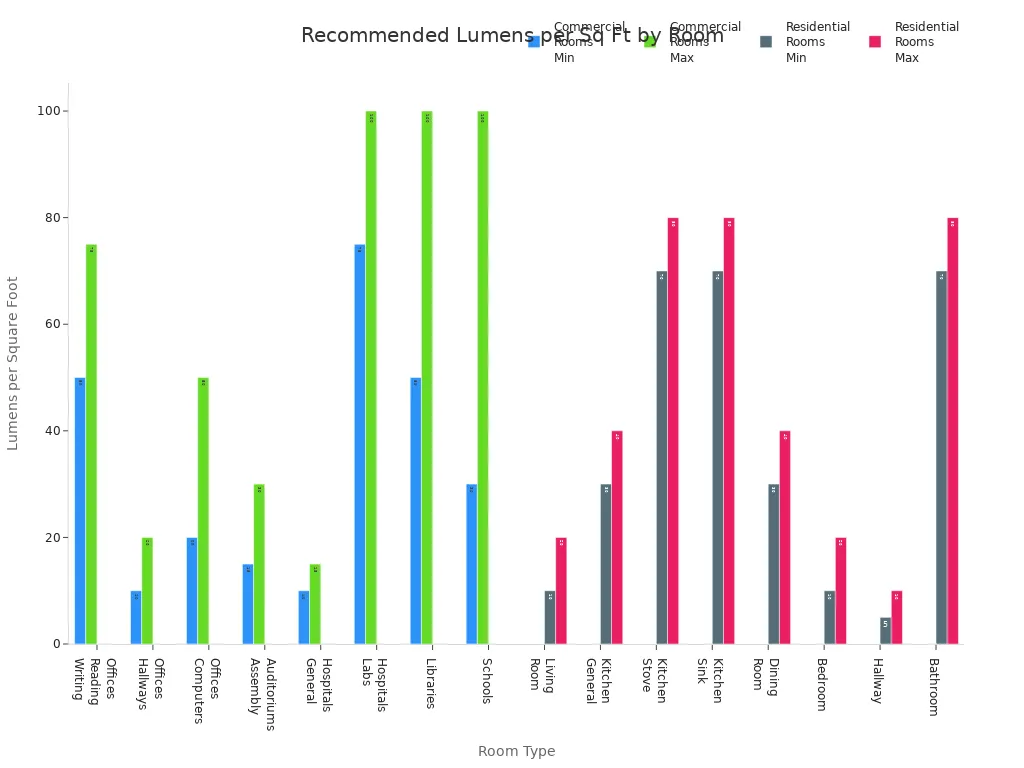
Your style matters just as much as function. The right fixture can pull a whole room together. Here are some tips to help you choose:
Match the finish of your lights with other hardware in the room, like cabinet handles or faucets. This creates a unified look, especially in kitchens, bathrooms, and entryways.
You can mix metal finishes, but keep one as the main color and use one or two others as accents. This keeps things balanced and interesting.
Repeat finishes throughout the space to tie everything together.
In rooms with lots of lights, keep the finishes consistent for a clean, intentional feel.
Pick materials that last and are easy to clean, especially in busy areas.
Place your lights so they work well with other hardware and don’t clash visually.
Note: The 5–7 Lighting Rule helps you layer light sources for a balanced look. Use odd numbers—like three, five, or seven—when grouping lamps or fixtures. For example, you might have three types of lighting: a ceiling light for ambient, a floor lamp for task, and wall sconces for accent. This makes your room feel lively and well-designed.
You can also boost your lighting’s efficiency by choosing lighter colors for your ceilings and walls. Surfaces with higher reflectance bounce more light around the room, so you don’t need as many fixtures or as much energy. For most rooms, aim for ceilings with at least 40% reflectance and walls around 60%. In bedrooms, keep ceilings at 40% and walls a bit lower for a cozy feel.
| Space Type | Ceiling Reflectance (%) | Wall Reflectance (%) |
|---|---|---|
| Living Room | 40+ | 60 |
| Bedroom | 40 | ≤40 |
| Office | 80+ | 70+ |
Designers often use fixtures that shine some light onto walls and ceilings. This trick makes rooms feel brighter and more comfortable without using extra energy.
Ambient lighting gives your room a soft, even glow. You use it to see and move around safely. It fills the space with gentle brightness, so you don’t get harsh shadows or glare. You can set the mood with warm or cool tones. Ceiling lights, chandeliers, recessed lights, wall sconces, and floor lamps all work well for ambient lighting. Natural sunlight from windows also helps. If you add dimmers or layer lights at different heights, you get more control over the atmosphere. Ambient lighting makes your space feel comfortable and welcoming.
Provides broad, diffused light for the whole room
Reduces eye strain and helps you relax
Works as the base layer for all other lighting
Tip: Try mixing ceiling lights with floor lamps to create a balanced look.
Task lighting helps you focus on activities like reading, cooking, or working. You want bright, direct light for these jobs. Desk lamps, under-cabinet lights, pendant lights, and wall-mounted fixtures are great choices. Adjustable lamps let you point the light right where you need it. In the kitchen, under-cabinet LED strips make food prep easier. In your office, a desk lamp helps you see your work clearly. Task lighting keeps you comfortable and productive.
| Room | Common Tasks | Best Fixtures |
|---|---|---|
| Kitchen | Cooking, cleaning | Under-cabinet LEDs, pendants |
| Bedroom | Reading, dressing | Bedside lamps, wall lights |
| Bathroom | Grooming, makeup | Vanity lights, LED strips |
| Living Room | Hobbies, reading | Floor lamps, table lamps |
Accent lighting draws attention to special features in your home. You use it to highlight artwork, shelves, or cool architectural details. Spotlights, track lights, and picture lights work well for this. Accent lights create focal points and add depth to your room. You can choose dimmable fixtures to set the mood or pick custom shapes for a unique look. Accent lighting makes your space feel more interesting and stylish.
Note: Place accent lights near artwork or shelves to make them stand out.
Decorative lighting adds personality and flair. Sconces, chandeliers, pendants, and flush mounts are popular choices. Sconces lead the market because they look good and work in many places. LED decorative lights save energy and come in lots of colors and shapes. Smart decorative lights let you change settings with your phone or voice. You see these fixtures in homes, hotels, and stores. Decorative lighting helps you show off your style and keeps your space fresh and modern.
Sconces and chandeliers create a focal point
LED options offer color and energy savings
Smart features make lighting easy to control
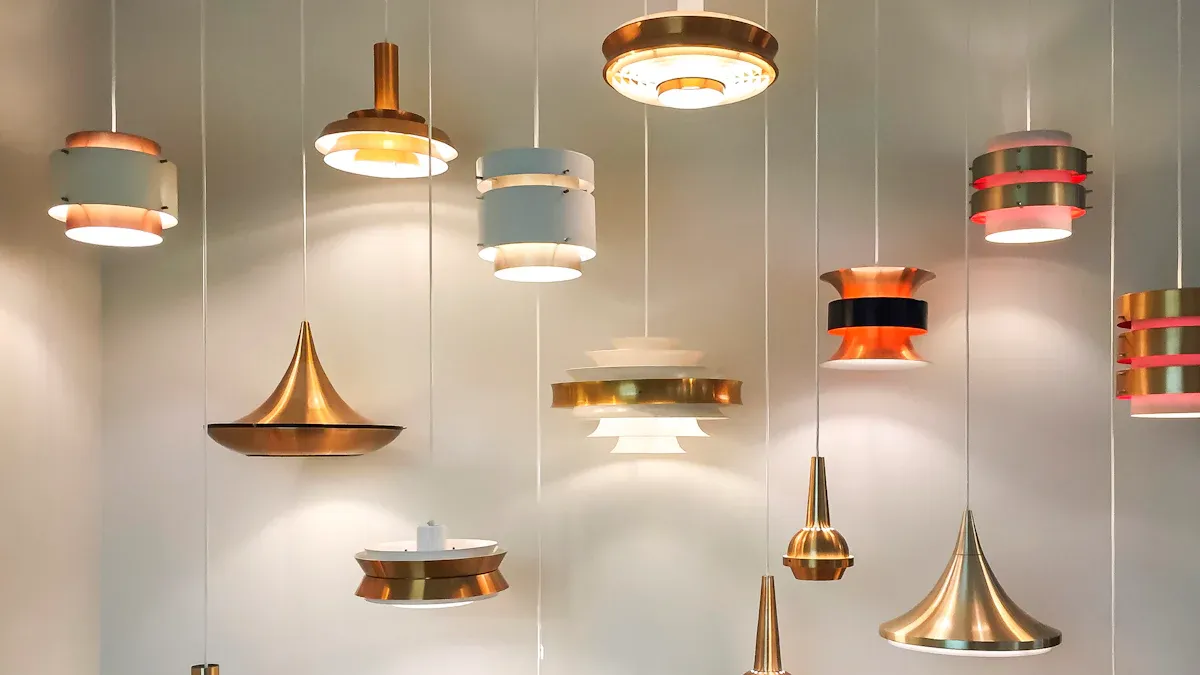
Ceiling lights come in many styles and sizes. You can choose flush mount, semi-flush mount, pendant, or chandelier. Each type works best in certain rooms. Here is a simple guide:
| Ceiling Light Category | Characteristics | Typical Residential Applications |
|---|---|---|
| Flush Mount Lights | Sits flat on the ceiling. Gives general light. | Good for hallways, bathrooms, and closets with low ceilings. |
| Semi-Flush Mount Lights | Hangs a little from the ceiling. Gives general light. | Works in entryways, kitchens, and bedrooms with higher ceilings. |
| Chandeliers | Hangs down. Has many bulbs. Stands out in a room. | Great for dining rooms, foyers, and big open spaces. |
| Pendant Lights | Hangs from the ceiling. Gives focused light. | Use over kitchen islands, sinks, or dining tables. |
| Recessed Lighting | Built into the ceiling. Can be ambient, accent, or task. | Good for kitchens, living rooms, and showers. |
| Track Lighting | Has lights on a track. You can move the heads. | Nice for living rooms, hallways, offices, or art displays. |
Pendant lights are great for kitchen islands. Chandeliers look fancy in dining rooms. Flush mounts fit in small spaces. You can use more than one type for a layered effect.
Wall lights save space and add style. You see them in hallways, stairs, and bedrooms. They make rooms feel warm and welcoming. Here are some good and bad things about wall lights:
Advantages:
Give focused light for reading or art.
Make small areas brighter.
Use less energy, especially with LEDs.
Disadvantages:
Light up a small area, so you may need more.
Can be hard to install because of wires.
Might cause glare or shadows if not placed well.
Tip: Use wall lights with ceiling lights for the best mix of brightness and style.
Lamps are easy to move and change. You can pick table lamps, floor lamps, or desk lamps. They give light for tasks and make rooms feel cozy. LED bulbs save energy and last longer. Lamps with dimmers or motion sensors give you more control. ENERGY STAR bulbs help you save even more power.
Recessed lights are built into the ceiling. They give soft, even light and keep the ceiling neat. Track lights sit on top and let you aim the light. Track lighting is easier to put in because it uses one power spot. Recessed lights need more work, like cutting holes and wiring. Use recessed lights for general light. Use track lights to show off art or work areas. Mixing both types gives your room a cool look.
Specialty fixtures are for special places like art studios or home theaters. Adjustable LED track lighting lets you change the direction, brightness, and color. It saves energy and shows colors well. Halogen accent lights make colors bright but get hot and use more power. Layered lighting mixes ambient, task, and accent lights for more options. Specialty fixtures need careful planning to get the right mood and coverage.
Note: Specialty lighting helps you set the perfect mood for hobbies, movies, or creative work.
When you pick a light bulb, you have three main choices: LED, incandescent, and CFL. Each type works differently and affects your energy bill and how often you need to change bulbs. Incandescent bulbs waste a lot of energy as heat and only last about 1,200 to 1,500 hours. CFL bulbs use less energy and last much longer—up to 15,000 hours—but they contain a little mercury and sometimes can’t be dimmed. LEDs are the best for saving energy. They last up to 35,000 hours, don’t get hot, and work well in all kinds of weather. LEDs also don’t have mercury, so they’re safer for your home.
Here’s a quick look at how these bulbs compare:
| Feature | Incandescent Bulbs | CFL Bulbs | LED Bulbs |
|---|---|---|---|
| Typical Wattage (60W eq) | 60W | 13-18W | 7-10W |
| Average Lifespan | 1,200 - 1,500 hours | 8,000 - 15,000 hours | 25,000 - 35,000 hours |
| Bulbs Needed for 25,000h | ~21 bulbs | ~3 bulbs | 1 bulb |
| Energy Cost (25,000h) | ~$169 | ~$52 | ~$30 |
| Total Cost over 20 years | ~$211 | ~$54 | ~$34 |
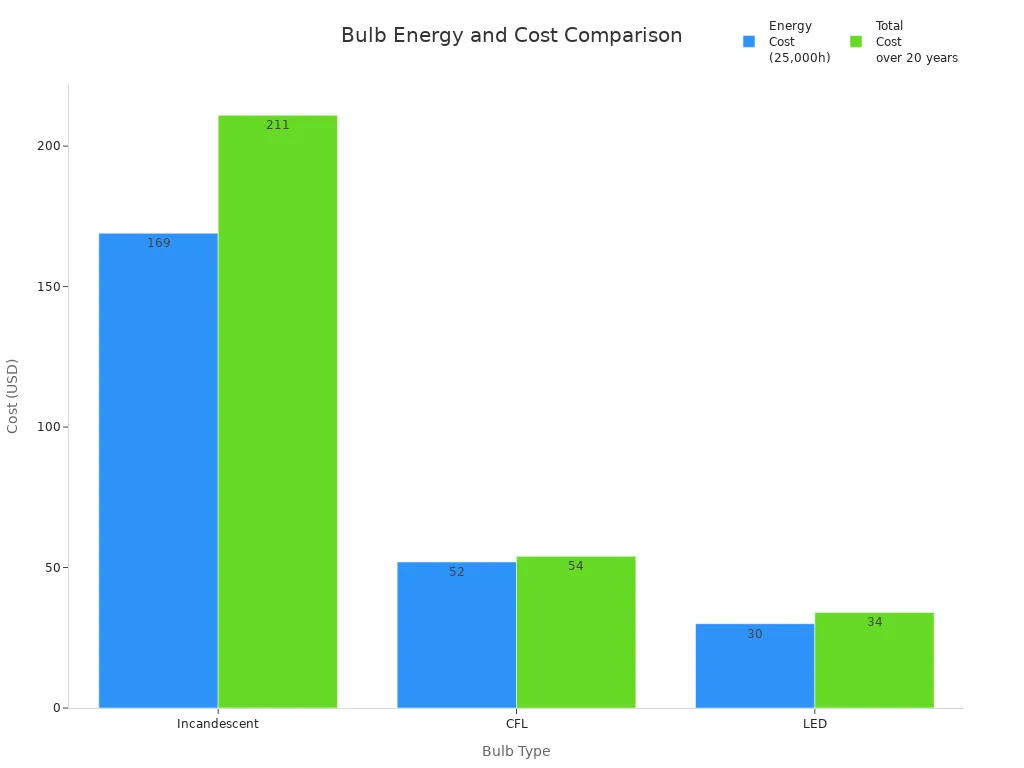
Tip: If you want to save money and help the planet, choose LED bulbs for most rooms.
Color temperature changes how a room feels. You measure it in Kelvin (K). Lower numbers (like 2700K) look warm and cozy, while higher numbers (like 5000K) look cool and bright. The color of your lights can even make you feel warmer or cooler, not just look that way!
Warm colors (lower Kelvin) make a room feel relaxing and comfortable.
Cool colors (higher Kelvin) help you feel alert and focused.
Your body reacts to color temperature. Blue light can wake you up and make you feel cooler, while yellow light feels warmer.
People like warmer lights in cold rooms and cooler lights in hot rooms.
You can use smart LEDs to change color temperature and set the mood for any activity.
Note: The right color temperature can boost your mood, help you focus, or make you feel more comfortable at home.
You want your lighting to match what you do in each room. Warm bulbs (2700K to 3000K) work best in living rooms, bedrooms, and dining rooms. They help you relax and make spaces feel cozy. For kitchens and bathrooms, use cooler bulbs (3500K to 4000K or even up to 5000K). These bulbs help you see better for cooking, cleaning, or getting ready in the morning. In garages or workspaces, very cool bulbs (7000K to 10000K) give you the most clarity.
Kitchens & Bathrooms: Use bulbs between 4000K and 5000K for clear, bright light.
Living & Dining Rooms: Pick bulbs in the 2000K to 3000K range for a soft, welcoming glow.
Bedrooms & Reading Areas: Choose warm bulbs (2700K to 3000K) to help you unwind. For reading, try a neutral 3000K bulb.
Utility Spaces: Go for very cool bulbs (7000K+) for the best visibility.
Tip: Dimmable or smart bulbs let you adjust both brightness and color temperature, so you can always set the perfect mood.
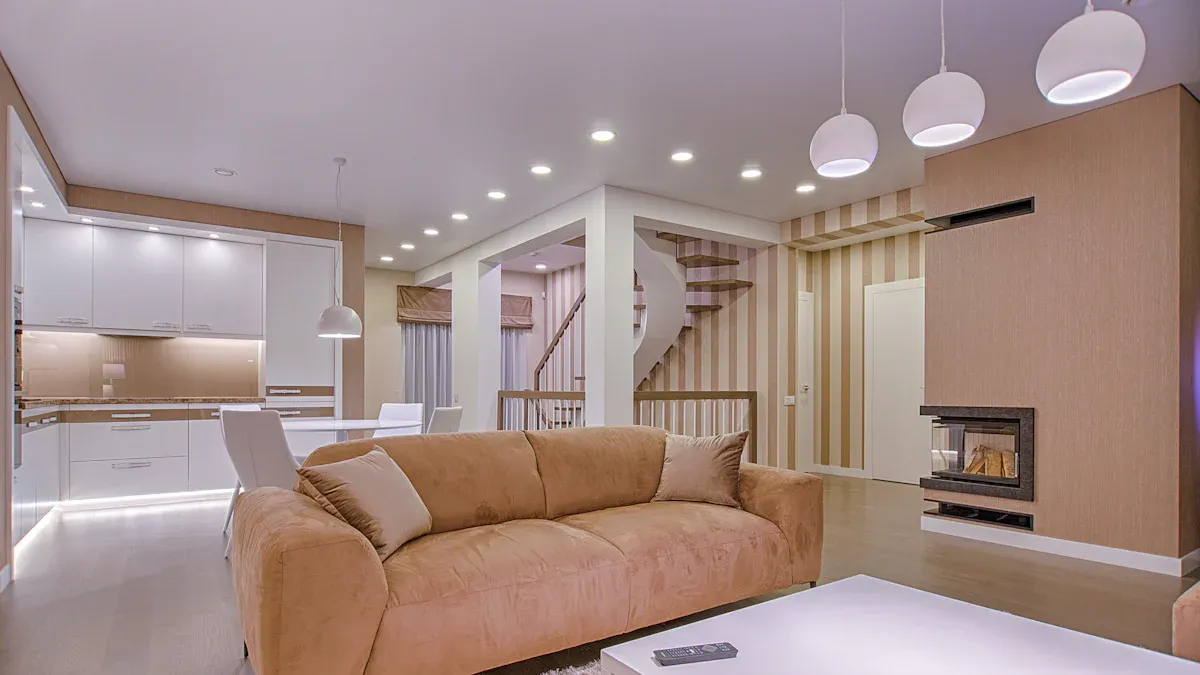
You spend a lot of time in your living room, so you want it to feel both cozy and bright. Start with ambient lighting like ceiling fixtures, chandeliers, or recessed lights for general brightness. Add table lamps or floor lamps for reading or hobbies. Use wall sconces or track lights to highlight art or special features. Mixing these layers helps you create a space that works for relaxing, watching TV, or hanging out with friends. Experts suggest aiming for 10–20 lumens per square foot in this room.
Ceiling-mounted fixtures or chandeliers for overall light
Table and floor lamps for tasks
Wall sconces or track lighting for accents
The kitchen needs bright, focused light for cooking and cleaning. Use ceiling lights for general lighting. Add under-cabinet lights for food prep and pendant lights over islands or counters. Layering these fixtures keeps every area well-lit and safe. Check out the recommended lumens per square foot for each kitchen zone:
| Kitchen Zone | Lumens per Sq Ft |
|---|---|
| General Areas | 46-65 |
| Food Prep Zones | 70-93 |
| Cooking Stations | 46-70 |
| Dishwashing/Cleaning | 28-46 |
| Dining/Service Counters | 18-37 |
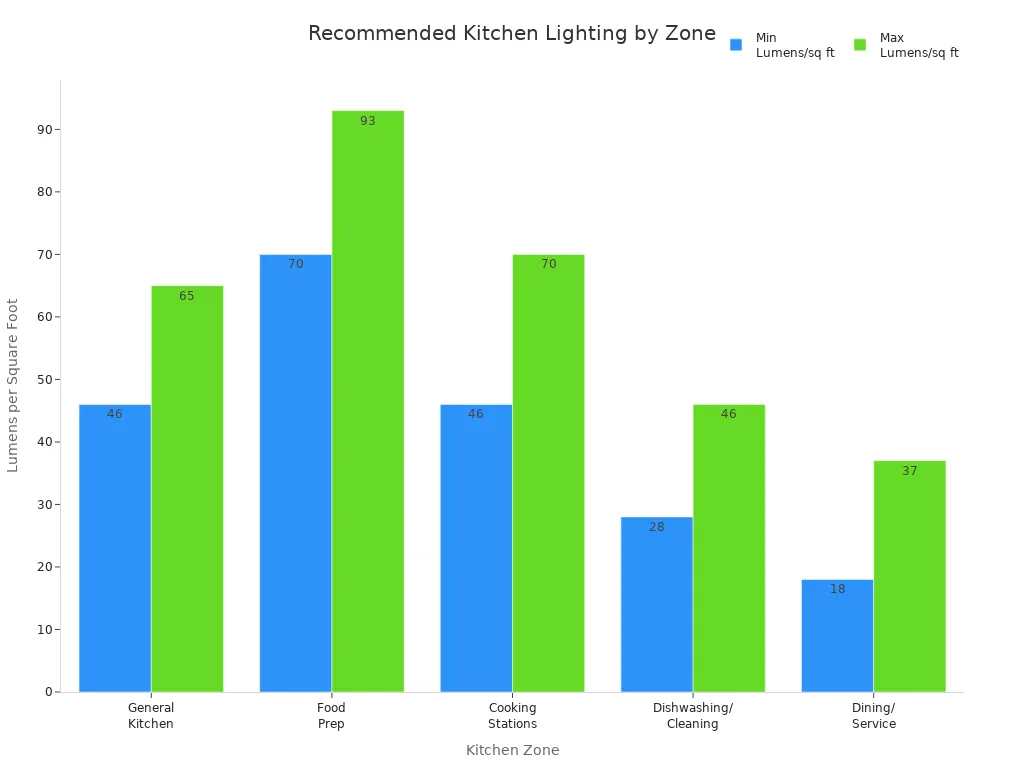
You want your bedroom to feel restful. Use a mix of ambient, task, and accent lighting. Try a ceiling fixture or flush mount for general light. Add bedside lamps for reading and wall sconces or tape lights for a cozy glow. Use dimmer switches to control brightness and choose warm bulbs (2700K–3000K) to help you relax. Layering lights lets you adjust the mood for winding down or getting ready in the morning.
Start with a ceiling fixture for ambient light.
Add bedside lamps for reading.
Install dimmers for easy control.
Safety and style both matter in the bathroom. Pick fixtures with the right safety ratings for wet areas. Use a ceiling light for general brightness. Place sconces on each side of the mirror to avoid shadows. Add LED strips or backlit mirrors for a modern touch. Aim for 70–100 lumens per square foot. Always use dimmers and energy-saving bulbs when possible.
Ceiling light for ambient lighting
Vanity sconces for task lighting
LED strips or backlit mirrors for accents
The dining room is all about setting the right mood. Hang a chandelier or pendant light above the table, about 30–36 inches from the surface. Use dimmable bulbs so you can switch from bright to soft light. Add wall sconces or buffet lamps for extra glow. Warm white light (2700K–3000K) makes meals feel inviting. Make sure your main fixture is about half the width of your table for balance.
Chandelier or pendant above the table
Wall sconces or buffet lamps for accents
Dimmable bulbs for flexible lighting
Good lighting in entryways and hallways keeps you safe and makes your home feel welcoming. Use recessed lights spaced 6–8 feet apart for even brightness. Add wall sconces near doors or mirrors for style. In tall spaces, try a pendant or chandelier. LED strips or cove lighting can highlight features and add a soft glow. Layering these lights helps you see clearly and adds personality.
Recessed lights for general lighting
Wall sconces for accents
Pendant or chandelier for tall spaces
LED strips for mood lighting
A well-lit home office helps you stay focused. Use a ceiling light for even brightness. Add a desk lamp with adjustable brightness for tasks. Wall-mounted fixtures or floor lamps can fill in dark corners. Choose bulbs between 4000K and 5000K to mimic daylight and reduce eye strain. Layering different lights lets you adjust for video calls, reading, or computer work.
Ceiling light for ambient lighting
Desk lamp for tasks
Wall or floor lamps for extra light
Use dimmable, flicker-free LEDs
Tip: Mixing and layering different types of interior lighting in every room gives you the best results for comfort, safety, and style.
You can make your home feel brighter and bigger by using more natural light. Open your curtains or blinds during the day. Place mirrors across from windows to bounce sunlight around the room. Choose light-colored walls and ceilings. These surfaces reflect sunlight and help you use less artificial light. If you have heavy drapes, try switching to sheer fabrics. You will notice your space feels warmer and more welcoming.
Tip: Clean your windows often. Even a little dust can block a lot of sunlight!
You want your lights to look good and work well. Pick fixtures that match your room’s style, but also think about what you do in each space. For example, a cool pendant light can make your kitchen look modern, but you still need bright task lighting for cooking. Try mixing different types of lights, like ceiling lights, lamps, and wall sconces. This gives you options for every activity.
| Style Tip | Function Tip |
|---|---|
| Match finishes | Use dimmers |
| Pick fun shapes | Choose right bulbs |
| Try bold colors | Layer your lighting |
Sometimes you need expert help. If you plan a big change or want to add new wiring, talk to a lighting designer or electrician. They know how to make your interior lighting safe and stylish. Professionals can help you pick the best fixtures and show you how to save energy. You will get a plan that fits your needs and budget.
Note: A quick chat with a pro can save you time, money, and stress!
Choosing the right interior lighting starts with looking at your space and thinking about what you need. Try mixing different fixtures and use smart, energy-saving bulbs like LEDs. These lights last longer, save money, and make your home feel better. Smart systems can even adjust brightness for you. If you feel unsure, talk to a lighting expert. Take the first step and transform your home with lighting that works for you and the planet!
Check the lumens on the bulb or fixture box. Multiply your room’s square footage by the recommended lumens per square foot. If you want a brighter space, pick a higher number. You can always add more lights if needed.
Yes! Mixing styles makes your space feel unique. Try using a modern ceiling light with vintage lamps or colorful wall sconces. Just keep one finish or color as your main theme. This helps your room look put together.
Warm white bulbs (2700K–3000K) work best for relaxing. They give off a soft, cozy glow. Use these in bedrooms and living rooms. You will feel calm and comfortable.
If you only swap bulbs or plug in lamps, you can do it yourself. For hardwired fixtures or new wiring, call a licensed electrician. This keeps you safe and makes sure everything works right.
